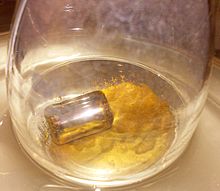User:OrganoMetallurgy/Drafts/Potassium graphite
| This is not a Wikipedia article: It is an individual user's work-in-progress page, and may be incomplete and/or unreliable. For guidance on developing this draft, see Wikipedia:So you made a userspace draft. Find sources: Google (books · news · scholar · free images · WP refs) · FENS · JSTOR · TWL |
| Identifiers | |
|---|---|
| Properties | |
| C8K | |
| Molar mass | 135.186 g·mol−1 |
| Appearance | bronze solid |
Except where otherwise noted, data are given for materials in their standard state (at 25 °C [77 °F], 100 kPa).
| |
non-chembox sections[edit]
Properties[edit]
Structure[edit]
Synthesis/Preparation[edit]
First synthesis
Most practical or most common synthesis or syntheses
Melting potassium over graphite
Applications/Uses[edit]
Powerful reducing agent
Reactions[edit]
History[edit]
References[edit]
stuff taken from graphite intercalation compound[edit]

One of the best studied graphite intercalation compounds, KC8, is prepared by melting potassium over graphite powder. The potassium is absorbed into the graphite and the material changes color from black to bronze.[1] The resulting solid is pyrophoric.[2] The composition is explained by assuming that the potassium to potassium distance is twice the distance between hexagons in the carbon framework. The bond between anionic graphite layers and potassium cations is ionic. The electrical conductivity of the material is greater than that of α-graphite.[2][3] KC8 is a superconductor with a very low critical temperature Tc = 0.14 K.[4] Heating KC8 leads to the formation of a series of decomposition products as the K atoms are eliminated:[citation needed]
- 3 KC8 → KC24 + 2 K
Via the intermediates KC24 (blue in color),[1] KC36, KC48, ultimately the compound KC60 results.
Reagents in chemical synthesis: KC8[edit]
The bronze-colored material KC8 is one of the strongest reducing agents known. It has also been used as a catalyst in polymerizations and as a coupling reagent for aryl halides to biphenyls.[5] In one study, freshly prepared KC8 was treated with 1-iodododecane delivering a modification (micrometre scale carbon platelets with long alkyl chains sticking out providing solubility) that is soluble in chloroform.[5] Another potassium graphite compound, KC24, has been used as a neutron monochromator. A new essential application for potassium graphite was introduced by the invention of the potassium-ion battery. Like the lithium-ion battery, the potassium-ion battery should use a carbon-based anode instead of a metallic anode. In this circumstance, the stable structure of potassium graphite is an important advantage.
- ^ a b Ottmers, D.M.; Rase, H.F. (1966). "Potassium graphites prepared by mixed-reaction technique". Carbon. 4 (1): 125–127. doi:10.1016/0008-6223(66)90017-0. ISSN 0008-6223.
- ^ a b Cite error: The named reference
InorgChemwas invoked but never defined (see the help page). - ^ NIST Ionizing Radiation Division 2001 – Major Technical Highlights. physics.nist.gov
- ^ Emery, N.; Hérold, Claire; Marêché, Jean-François; Lagrange, Philippe; et al. (2008). "Review: Synthesis and superconducting properties of CaC6". Sci. Technol. Adv. Mater. (PDF). 9 (4): 044102. Bibcode:2008STAdM...9d4102E. doi:10.1088/1468-6996/9/4/044102. PMC 5099629. PMID 27878015.
- ^ a b Chakraborty, S.; Chattopadhyay, Jayanta; Guo, Wenhua; Billups, W. Edward; et al. (2007). "Functionalization of Potassium Graphite". Angew. Chem. Int. Ed. 46 (24): 4486–8. doi:10.1002/anie.200605175. PMID 17477336.

